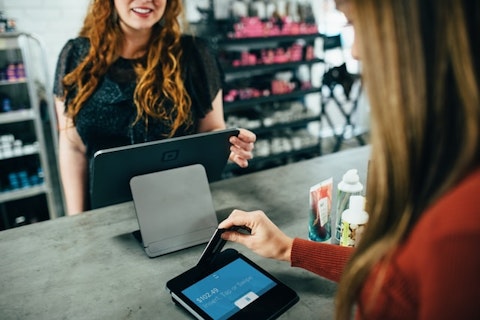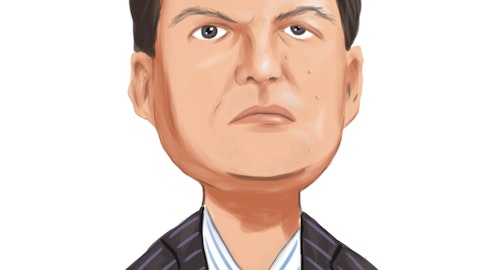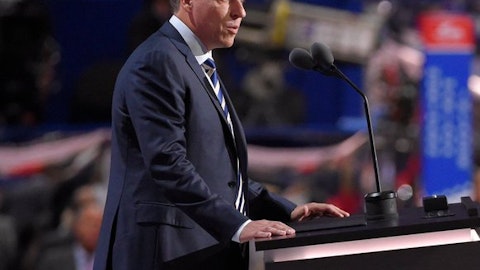Qurate Retail, Inc. (NASDAQ:QRTEA) Q1 2023 Earnings Call Transcript May 5, 2023
Qurate Retail, Inc. beats earnings expectations. Reported EPS is $-0.05, expectations were $-0.08.
Operator: Greetings, and welcome to the Qurate Retail Earnings Call. At this time, all participants are in a listen-only mode. A brief question-and-answer session will follow the formal presentation. [Operator Instructions]. As a reminder, this conference is being recorded. It is now my pleasure to introduce your host, Shane Kleinstein. You may begin.
Shane Kleinstein: Thank you, and good morning. Before we begin, we’d like to remind everyone that this call includes certain forward-looking statements within the meaning of the Private Securities Litigation Reform Act of 1995. Actual events or results could differ materially due to a number of risks and uncertainties, including those mentioned in the most recent forms 10-K and 10-Q filed by our company and QVC with the SEC. These forward-looking statements speak only as of the date of this call and Qurate Retail expressly disclaims any obligation or undertaking to disseminate any updates or revisions to any forward-looking statement contained herein to reflect any change in Qurate Retail’s expectations with regard thereto, or any change in events, conditions or circumstances on which any such statement is based.
Please note that we have published slides to accompany the earnings release. On today’s call we will address certain non-GAAP financial measures, including adjusted OIBDA, adjusted OIBDA margin, free cash flow and constant currency. Information regarding the comparable GAAP metrics along with required definitions and reconciliations including preliminary note and schedules one through four can be found in the earnings press release issued today or our earnings presentation, which are available on our website. Today, speaking on the earnings call we have Qurate Retail, President and CEO, David Rawlinson; Qurate Retail Group’s new CFO, Bill Wafford; and Qurate Retail Executive Chairman, Greg Maffei. I will turn the call over to, David Rawlinson.
David Rawlinson II: Thank you, Shane, and good morning to everyone. Thank you for joining us today and for your interest in Qurate Retail. We saw meaningful improvement in revenue trends in the first quarter at our largest businesses QVC U.S. And QVC International, both of which declined only low-single-digits even against the challenged retail backdrop. Performance was soft at our smaller businesses, HSN, Cornerstone and Zulily. Volume remains pressured due to our customer file, which I will discuss in more detail shortly. While we have multiple efforts underway to reactivate customer groups, we expect the impact of these initiatives to take several quarters. Against this backdrop, we are intensely focused on near-term factors within our control, most notably cost management and driving increased sales price.
We believe we are on track to deliver our objectives for Project Athens, our three year plan to establish revenue stability, margin expansion and incremental free cash flow generation. Our turnaround is well underway, and we are encouraged by early signs of stabilization particularly at QVC U.S. HSN is slightly behind QVC U.S. and to implement similar pricing strategies and their performance was also impacted by promotional shipping offers tested in the quarter that did not drive the expected volume gains and have since been discontinued. They were also impacted by reduced marketing spend. Focusing on QxH, our adjusted OIBDA in the quarter included $35 million of headwind from two specific items. Nearly 60% was transformation costs related to Project Athens that impacted our SG&A, and the remainder was primarily an adjustment related to processing returns in the wake of the December 2021 fire at our Rocky Mount fulfillment center.
Rocky Mount was our primary return center for QVC U.S. This represented a true-up related to a backlog and processing returns following the buyer. Despite these headwinds, I’m pleased with the significant progress we made and initial margins from our pricing and merchandising efforts. We expect to see material improvement and our profitability in the back half of this year. Free cash flow improved $174 million year-over-year mainly due to increased cash from operations that reflected working capital improvements. We continue to have strong liquidity and we believe our capital structure has the runway to get us through this transition. Bill, will discuss each of our businesses and free cash flow in more detail momentarily. Looking at trends in the retail industry, the environment continues to be very promotional as most retailers did not reduce inventory to the extent we did in 2022.
Inflation remains elevated, interest rates are rising and consumer sentiment is low by historic standards. Against this backdrop, we are focusing on the actions within our control including meaningful cost cutting initiatives. As we said on our last call, QVC U.S. and HSN eliminated approximately 400 positions in late February that is expected to generate $60 million in all-in run-rate savings, with $50 million benefiting 2023. We have not experienced any meaningful disruption from the workforce reductions and their operating efficiently. In March, Zulily eliminated 85 positions that are expected to create annual savings of approximately $14 million with $11 million benefiting 2023.We actively renegotiated import freight contracts during the past six months to take advantage of lower market rates.
As a result, our rates for import rate declined 30% year-over-year and more than 60% from their peak in August 2021. It will take time for these savings to flow through our P&L, as freight costs are included in product costs and the impact of P&L once the item is sold. We have additional cost saving initiatives in process throughout our business. As a reminder, as part of Project Athens, we expect the OIBDA improvement in 2023 will be mostly cost and margin driven and weighted towards the back half of the year, reaching run-rate in 2024. Turning to our customer file. I want to acknowledge that this is a key focus as we execute our transformation. I’ve talked previously about the roll-off of less sticky customers that came in during the pandemic, who made purchases online but often didn’t interact with our poor video commerce offering.
In addition, the Rocky Mount Fire had a material impact on our customer count. Significantly impacting our merchandise assortment, order to delivery times and overall customer satisfaction. Our customers are accustomed to a higher level of service from our brands. As we show on slide seven in our earnings presentation, our existing customers generated nearly 90% of sales in the trailing 12 months. New and reactivated customers have a significant influence on our customer count as they represent 46% of total customers, yet make up only 10% of our sales. Therefore, as we undergo our transformation, we have heightened our focus on existing customers through merchandise, pricing and programming strategies. We are seeing encouraging results. Existing customers purchased on average 30 items and their spend grew to $1,500 dollars per customer and the 12 months ended March 31.
They increased their spend. This increase in their spend was important to the moderation in QxH’s revenue decline relative to 2022 and we are actively focused on driving this continued growth. We have several initiatives already underway to retain and reactivate customers. Many of these efforts come from enhancing fundamental execution through Project Athens’s workstreams. Starting with our merchandise strategy, we meaningfully improved the freshness of our merchandise, enhanced programing, brought back day of urgency in our TSV offerings and focused on driving higher average sales price. As previously communicated, QxH reduced inventory 25% in FY 2022. As a result, we were able to bring in fresh merchandise in Q1. At QVC, we experienced success with new brands including Canyon Retreat, our own private label apparel offering.
The jewelry brand, Effy, as we embark on an enhanced jewelry strategy and OMI WellBeauty supplements in our wellness category. Managing towards higher average sales price and driving incremental spend among our customers is important and driving topline improvement while our customer funnel is replenished. We are driving average sales price through tailored price increases as well as managing our product assortment into higher priced subcategories, especially within apparel and accessories for our best customers over index. For example, throughout the pandemic, our customers naturally rotated into purchasing more loungewear. Our customers saturated now in category, and after cleaning out this inventory, our merchandising team is seeing strength in higher priced apparel subcategory such as dresses and denim.
We also leaned in the higher price point accessories, including leather handbags. We saw good traction in Q1 and will continue to be a focus. Electronics remains a challenging category across the industry, reflecting a lack of innovation, which especially impacts our HSN business, where the category is more highly penetrated. While still an important component of the overall mix, we did emphasize reliance on this category in Q1. The pricing efforts are materializing in our results with QxH average sales price up 2%. Average spend per customer increased 11% in the first quarter because of Project Athens initiatives. Going forward, we are better leveraging the insights of our pricing strategies and data analysts to enhance our merchandise planning strategy and augment our pricing capabilities.
We will track all pricing decisions rigorously, so the team can better analyze, measure and recommend pricing actions to drive sales and margin. We also improved our service promise to customers. At QxH, 84% of packages were shipped within 48 hours in Q1, up from 69% in Q1 2022, and our order to delivery time decreased by half a day. We still have work to do here and aim to further reduce our order to delivery times. There are several other efforts underway tailored to serving our best customers. We are inviting customers to exclusive live shows and live stream events to meet with hosts and get early access to brand launches. We’re offering targeted special promotions on product. We’re making outbound calls from customer service to show appreciation for our best customers and address any concerns.
Key hosts are making outbound calls and sending thank you notes and videos, leveraging the trust and relationships they uniquely share with our customers. We look forward to learning from these efforts, adapting from those that do not work well and leaning into those that do. QVC and HSN are leveraging celebrities just as we’ve done throughout our history. Our platforms continue to be a relevant home for these personalities to launch and promote their brands, telling their stories, and demonstrating their product’s life. In Q1, QVC teamed up with Carla Hall to launch our new product line Sweet Heritage, a collection of kitchen and food items. Carla is a trained chef, popular TV personality from Top Chef and culinary author with nearly $0.5 million Instagram followers.
Additionally, HSN collaborated with Christian Siriano to launch C. Wonder, a collection of ready-to-wear apparel style exclusive to HSN. Christian is an award fashion designer with more than $2 million Instagram followers. In March, we named actor, best-selling author and disability advocate Selma Blair as QVC U.S. Brand Ambassador for Accessibility. We launched a dedicated, accessible and adaptive merchandise category with hundreds of products spanning fashion, home, electronics and beauty. This makes QVC one of the first U.S. retailers to Qurate a full lifestyle of accessible products into a single multi-category offering. From a programming perspective, we conducted our first live audience shows in two years with “In the Kitchen with David” and a cooking show to launch the Carla Hall new culinary product line.

Photo by Blake Wisz on Unsplash
We invited our most loyal customers to join us in the studio and held a meet-and-greet prior to the shows. Both shows are strong ways to further enhance our customer relationship. For six weeks, from February and the March, QVC U.S. aired a pilot program called “Over 50 & Fabulous”, connecting with our four demographics, Mally Roncal hosted the show, which featured a different topic each week, including empty nesting, menopause, life advice and treating yourself. The pilot’s objectives were to drive viewership, increase digital traffic, create social engagement, bring in new customers and of course generate sales. On average, 595,000 households tune-in to the on air program. 12 shows on QVC.com, Facebook, QVC+ and YouTube had more than 8.7 million video views and reached more than 16 million people.
Three quarters of the digital visitors were new to QVC.com and 60% of sales were consistently from our most loyal customers. And overwhelmingly, we receive positive customer feedback on social platforms. We plan to continue the pilot monthly, testing, learning and adapting. Then we plan to resume the weekly cadence in Q3 for another six to eight weeks. In early April, QVC International launched the key initiative, the Integrated Experience, which aims to turn QVC International into the ultimate shopping destination for specific categories. Initially, we are focused on two categories. We launched gardening in the UK in early April and expect to start food in Germany in Q2. It incorporates TV, web and app content into one simplified experience, offering customers differentiated product assortment, innovative programming and live experiences across platforms.
It allows like-minded people to share their knowledge and learn from each other. These capabilities are being brought to life in a portable and scalable way, which will allow us to deploy them across multiple markets and additional focus categories. Shifting now to our streaming business and our actions to create new revenue streams. We continue to grow engagement on our streaming platforms. The total minutes viewed on our app-based streaming services increased 13% year-over-year. We reduced marketing spend in the quarter, but are planning to support streaming more aggressively in the second half of the year. In mid-March, we launched a beta of our next-generation video and live stream shopping platform and app called Sune, spelled S-U-N-E.
The format is mobile-first, short-form and summable. The shopping content and brands featured are unique entertaining and engaging. We are targeting different customers than our traditional audience, Gen Z and young millennials, who are digitally native and actively shopping via video content on other platforms, and seeks to develop personal between these customers, influencers and new up and coming brands and founders. During the public beta phase, we will look to scale, add more functionality, expand brand and product assortment and further personalize the shopping experience. Now turning to our non-video commerce businesses, starting with Cornerstone. Performance softened in Q1, this is partly due to comping its all-time best first quarter in 2022, but also reflects saturation in the home and home furniture market.
Zulily’s performance was disappointing. National brands are performing well, but we are seeing pressure in unbranded vendors. We took additional cost actions in March that will benefit future quarters. Bill, will discuss more momentarily. In closing, we’re seeing improved revenue stabilization at our largest video commerce businesses, good initial innovation in our customer experiences and continued opportunities to reduce costs. Our results are still far from where we want, and we recognize we have a lot of work to do to get the business to where it needs to be. We are intensely focused on delivering our Project Athens revenue, OIBDA and free cash flow outcomes. I would like to thank Jim Hathaway for serving as Interim CFO of QRG. We would greatly appreciate his hard work during this transition, and I look forward to continuing to work with him as CFO of QVC.
I would also like to welcome Bill Wafford, Qurate Retail Group’s new CFO. We are excited to have him on board, to leverage his 25 years of experience in corporate finance, management consulting and executive leadership across retail, consumer goods and digital businesses. I’ll turn the call to Bill, to discuss the details of each of our businesses.
Bill Wafford: Thank you, David, and good morning, everyone. I’m very pleased to join David and the entire team. I look forward to speaking with many of you over the coming quarters. Unless otherwise noted, my comments compare financial performance for the three months ended March 31, 2023 to the same period in 2022. Starting with QxH. Revenue declined 5% primarily on lower unit volume, reflecting fewer customers and reduced shipping and handling revenue primarily at HSN. These pressures were partially offset by 2% growth in average selling price from a mix of elevated product assortment and price increases. From a category perspective, QxH experienced declines mainly in electronics, beauty and home. We did, however, experienced a moderation in the rate of year-over-year decline for most categories versus Q1 ‘22.
This improvement reflects our elevated merchandise strategy and focus to lean into higher price and margin categories and products at QVC and HSN, and our reduced focus on electronics. QVC U.S. is further along in these efforts and topline performance meaningfully approved in the first quarter. HSN is focusing on similar pricing and merchandise strategies there was a higher penetration of electronics, which impacted its relative performance. Home revenue declined 2% which was a material improvement from the mid-teens decline in Q1 2022. In Q1 2023, we experienced lower demand largely for kitchen, electrics and cleaning partially offset by strong growth in food. Apparel was essentially flat on top of low-single-digit growth in Q1 2022. This year’s performance was primarily due to strength in denim, dresses and swimwear, partially offset by contemporary apparel.
We are rotating airtime into these areas of strength and emphasizing higher price point subcategories in our mix. Beauty declined 6% mainly due to weakness in beauty devices and hair care. Electronics revenue declined 25%, in part due to category softness in the market. We are strategically pulling back on electronics airtime as we focus on higher margin fashion categories were our best customers over index. Adjusted OIBDA declined $86 million or 38% with adjusted OIBDA margin decreasing 470 basis points. We are incurring certain cost associated with our transformation, some of which are included in adjusted OIBDA and some such as severance or below the line. The expected Project Athens $300 million to $600 million run-rate OIBDA opportunity we articulated to the market is net of associated costs.
There will be some timing impact as we incur costs while the transformation initiatives are put in-place, but before benefits run rate. In particular, in the first quarter, our adjusted OIBDA was pressured by $21 million of costs associated with Project Athens’ transformation that were included in SG&A. These costs are non-recurring in nature or non-operating in nature, sorry, and we expect to incur additional expense associated with the transformation through 2023, after which these costs should dissipate. Now, looking at the rest of our QxH adjusted OIBDA performance. Gross profit declined 160 basis points, mainly due to fulfillment and product margin pressure, partially offset by favorable inventory obsolescence. While product margins decreased, initial product margins improved 180 basis points driven by price increases and a favorable mix into higher margin products.
These gains were offset by reduced shipping and handling revenue due to lower volume and the shipping promotions at HSN. Also, as David mentioned, we incurred a $14 million true-up in the first quarter to catch up in processing returns following the Rocky Mount Fire. As a reminder, Rocky Mount was our primary returns facility and due to the complexities of processing returns in multiple locations, and the lack of a common IT system, we revised our estimate for our return provision in the first quarter. Fulfillment expenses reflect higher outbound freight rates and wages largely due to inflation. Fulfillment center rent from the sale leaseback transactions completed in ‘22 of approximately $8 million. Higher return processing costs and increased drop-ship penetration, these pressures were partially offset by less detention and demurrage costs.
Inventory obsolescence favourability was a result of the 33% year-over-year inventory reduction at QxH. Operating expenses were unfavourable approximately 60 basis points, primarily due to increased commissions from our mix of scripted sales and expanded linear distribution. SG&A was unfavourable approximately 240 basis points. $21 million of the SG&A pressure is from the aforementioned transformation related costs associated with Project Athens. We had approximately 55 basis points of sales deleverage and modest expense associated with building our live stream business soon which launched in beta in March. Marketing expenses decreased year-over-year primarily due to less spending on core media. Moving to QVC International. My comments will focus on constant currency results.
Revenue declined 3% primarily on lower unit volume and reduced shipping and handling revenue. QVC Japan was essentially flat, experiencing high inflation as well as reduced viewership in March due to the country’s strong interest in the world baseball classic. Our largest European businesses, Germany and the UK, declined in the mid-single digit and experienced soft consumer sentiment in part attributed to historic inflation. PVC International increased average selling price 5% due to price increases and favourable product shift into higher price point home products in Germany and health fitness and apparel in Japan. From a category perspective, QVC International experienced declines in electronics, jewelry and home, which were partially offset by gains in apparel accessories and beauty.
Adjusted OIBDA decreased 23% and adjusted OIBDA margin declined 330 basis points, primarily driven by higher administrative and fulfilment costs. Gross margin declined mainly due to fulfilment expenses, which reflect higher warehouse labour costs in Germany and the UK and $4 million in rent following the sale leaseback transaction in January of this year. SG&A was unfavourable mostly due to higher fixed costs from wages, benefits and outside services. Moving to Cornerstone. Revenue declined 13% in the first quarter. Cornerstone was comping its all-time best first quarter in the prior year and on a two year basis, revenue grew 4%. While our business managed its inventory balances very effectively heading into the first quarter, the broader home industry remained highly promotional in the first quarter, requiring Cornerstone to increase promotions to stay competitive.
We experienced softness in home accessories, outdoor furniture and kitchen as well as an apparel at Garnet Hill. Adjusted OIBDA decreased $27 million mainly due to volume decreases, increased promotional activity, higher marketing and warehouse expense as well as higher fixed cost overhead due to opening new stores in Austin, Texas and Charleston, South Carolina in the first quarter as well as in West Palm, Florida in September of 2022. These headwinds were partially offset by lowering down logistics costs. Looking at Zulily. Revenue declined 17% mostly due to lower unit volume and reduced shipping and handling revenue. These pressures were partially offset by 9% increase in average selling price due to a favourable product mix within national brands and footwear.
Adjusted OIBDA loss increased $13 million largely due to lower product margins, reflecting shipping, handling and site promotions, as well as increased marketing expense and higher inventory obsolescence. These headwinds were partially offset by lower fulfilment and fixed cost. Now turning at the balance sheet and cash flow. Total capital expenditures were $54 million in Q1 and we spent $38 million on renewals of our TV distribution contract, an increase of $36 million over prior year. As a reminder, TV distribution contracts are generally renewed on a two year cycle. Total free cash flow for the first three months of 2023 was a use of $70 million versus a use of $244 million last year. The year-over-year improvement was primarily attributable to increased cash flow from operations, partially offset by higher TV distribution payments.
The operating cash flow increase was largely driven by working capital improvements from inventory receivables and payables. QxH inventory was down 33% year-over-year. Looking at our debt profile. On March 31, we had $1.3 billion drawn on the QVC revolver with $1.9 billion in available capacity. Looking at our cash balances, as of March 31, Qurate Retail had total cash of $1.3 billion of which $421 million is at QVC Inc. Our leverage ratio as defined by the QVC revolving credit facility was 2.5 times. Note that covenant OIBDA includes the adjusted OIBDA of QVC, Cornerstone and Zulily, as well as gains on sale leaseback transactions for the four quarters following such transactions and as of the beginning of this year also includes a portion of expected cost savings.
Our covenant OIBDA for purposes of our leverage ratio as of March 31st, includes approximately $225 million of such savings. Finally, on an administrative note, on May 1st, we received notice from NASDAQ that QRTEA’s closing bid price had fallen below $1 per share for 30 consecutive business days. This notice begins a period of 180 calendar days to regain compliance, which means the stock needs to have a closing bid of $1 or more for 10 consecutive business trading days for continued listing on NASDAQ. Additionally, we may be able to take advantage of an additional 180 day compliance period, which means we could have up to 360 days. Importantly for our management, we are focused on executing our transformation and driving improved financial performance.
We took significant action throughout 2022 to create liquidity and position ourselves to execute Project Athens. We have sufficient cushion relative to our 4.5 times maximum net leverage covenant threshold in our credit facility. Our suppliers and partners have been very supportive of Qurate businesses as we manage through our transformation and we continue to look forward to continuing these long standing relationships. With that, I’ll turn the call over to Greg.
Gregory B. Maffei: Thank you, David and Bill. We were pleased to see the performance improvement at our two largest businesses, QVC U.S. and QVC International with revenue only down single-digit in a very choppy retail market. This is a significant improvement. I’d also know we took actions to right size costs during the quarter, but will mostly benefit future periods. We were disappointed by the augmented pressure during the quarter, but it’s worth reiterating that the improvement in underlying operations at QxH was masked by $14 million related to the revised returns provision and $21 million of transformation related costs incurred during the period. As was noted before, we believe the capital structure we have has runway to get us through our transition, and we have a covenant of 2.5 times currently leverage relative to the 4.5 covenant in the revolver.
We do expect upcoming free cash flow will be applied to debt repayment and will manage towards our stated leverage target of 2.5 times. We did repay $214 million of the 2023 maturity in March this year this quarter. And we also settled $153 million of exchanges on the 1.75% charter bonds during the quarter plus $94 million that settled after quarter end. These bonds have an October 23 put call date which was pulled forward in timing with these recent exchanges. I would also note there is no DTL associated with these 1.75% charter bond retirements. We will continue to assess other opportunities to improve our balance sheet. And with that, operator, I’d like to open up the line for Q&A.
See also 10 Best Socially Responsible Stocks to Buy and 12 Best Fast Growth Stocks to Buy Now.
Q&A Session
Follow Qurate Retail Inc. (NASDAQ:QRTEA)
Follow Qurate Retail Inc. (NASDAQ:QRTEA)
Operator: Thank you. We will now be conducting a question-and-answer session. [Operator Instructions]. Our first question comes from Carla Casella with JPMorgan.
Operator: Thank you. Our next question comes from Jason Haas with Bank of America.
Operator: Thank you. Our next question comes from William Reuter with Bank of America.
Operator: Thank you. Our next question comes from Hale Holden with Barclays.
Operator: Thank you. Our next question comes from Karru Martinson with Jefferies.
Operator: Thank you. Our last question for today comes from Carla Casella with JPMorgan.
David Rawlinson II: Thank you. And I think that’s it, operator. Thank you to all of our listening audience for your time and your questions. We hope to speak with you again next quarter if not sooner. And have a great Friday.
Bill Wafford: Thank you.
Operator: This concludes today’s conference call. You may disconnect your lines at this time. Thank you for participation.




